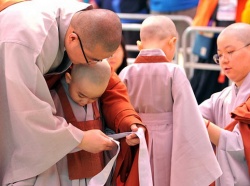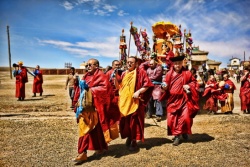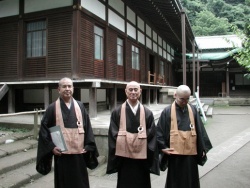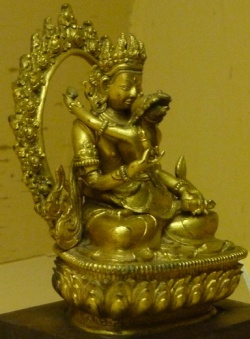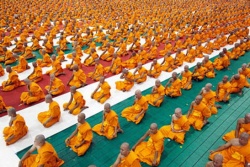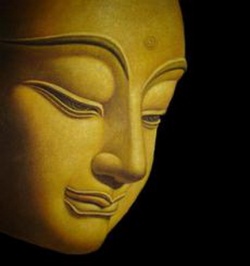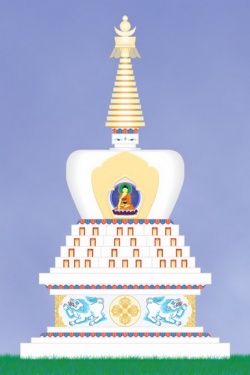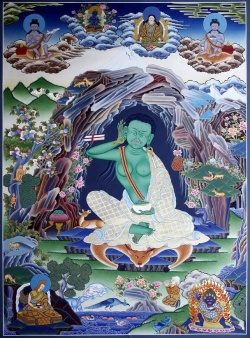An Exposition of Four Indian Buddhist Schools
by Todd Fenner, Ph.D.
With regard to the view in the nine yanas, the explanation of the Nyingma is a unique one in that it connects the views of the yanas with the philosophical schools so that sravakayana is connected with the view of the Vaibhasika and so on. A good summary is in the appendix to the book 'The Life of Shabkar'. An extensive explanation is in Dudjom Rinpoche's magnum opus on the Nyingma Lineage. Unfortunately it costs over $200.
So I think it would be best to work through the classical tenet systems of Vaibhasika, Sautrantika, Yogacara and Madhyamika along with some of the subdivisions. I will also address the issue of Prasangika and Svatantrika that Namdrol rightly raised and try and explain both sides of the issue. Before doing that however, I want to make some comments. There are differences in Madhyamika, Mahamudra, Dzogchen etc. however the differences lay in method not view. In usage, that distinction is not usually made explicit, so it can sometimes be confusing. Thus each refers to certain meditation methods to attain the view as well as the view itself. Sometimes certain scholars, favoring certain techniques have thus rated one superior to the other but this is questionable as all of them are functional, that is they produce realization. Likewise with regard to tantra, the actual view in all tantra sets is identical between the sets and to that of sutrayana. The difference is in the consciousness cognizing the view. So I will try and go into the view irregardless of the consciousness cognizing it. This greatly simplifies the explanations. In samadhi, the distinction between consciousness and the object is like water poured into water.
Subj: The View II Date: 95-11-28 10:48:55 EST From: Jamyang
Tibetans generally classify tenet systems into four broad categories Vaibhasika, Sautrantika, Yogacara, and Madhyamika. In reality the systems are much more diverse. The source of the views of the Vaibhasika and Sautrantika come primarily from the Abhidharmakosa by Vasubandhu and commentaries. The Yogacara from Maitreya, Asanga and Vasubandhu (he changed his mind) and the Madhyamika from Nagarjuna and Aryadeva. There is a classification of Madhyamika into Svatantra and Prasanga. The former stems from Bhavaviveka, Santiraksita and Kamalashila and the latter from Buddhapalita and Chandrakirti. The Gelug and perhaps others, place Dignaga and Dharmakirti between Sautrantika and Yogacara. They call their writings which seem to affirm the true existence of external objects Sautrantika following reason and those writings which seem to deny the true existence of external objects Yogacara following reason.
The classifications are largely(not entirely by any means) Tibetan ways of organizing the varied teachings. For instance, Tibetans use the term Vaibhasika to refer to the original 18 schools which include Theravada. In reality the 18 schools often had very distinctive ideas and did not consider themselves as one. It should be pointed out that the Abhidharma teachings in Theravada are quite a bit different than those in the Abhidharmakosa. The term Vaibhasika as used by Vasubandhu is restricted to one of the 18 schools which existed in Kasmir and produced a work called the Mahavibhasa (Great Commentary). This work exists now in Chinese but was never translated into Tibetan. For more information of this nature see Jeffrey Hopkin's chapter on Tibetan Doxography in 'Tibetan Literature, Studies in Genre' newly published by Snow Lion. By the way I wrote chapter 27 (little plug).
The Tibetans consider the study of the four systems to be like a progressive meditation because the definition of 'selflessness' becomes subtler and subtler and so the schools serve as a bridge or a ladder. The notion of doing it this way is reinforced by the Hevajra Tantra which explicitly advises one to progress in this fashion.
It should also be pointed out that there are a number of differences in the systems regarding the path, the idea of a final vehicle etc. besides the view concerning selflessness and ultimate truth. For a run down on all these see Geshe Sopa and Jeffrey Hopkins 'Cutting Through Appearances'.
Subj: View III Date: 95-11-29 11:09:38 EST From: Jamyang
The argument for selflessness is simple in structure and can be found in all the tenet systems. It is that if something truly exists or inherently exists it must be findable either through direct perception or by inference. The process is like the search in chemistry and physics for the basic units of matter. If something can be demonstrated to be capable of being broken down it isn't the basic unit. The tenet systems in regard to the analysis of self, all follow this basic approach. What sets them apart (other than a number of other issues) is the degree to which it is claimed that a basic unit is or is not established.
The purpose in performing this exercise is not the winning of debates or of playing intellectual games. That point is reiterated countless times by the Masters. Tsongkapa, whose reputation as a scholar is agreed by all, including opponents as being of the first order, said that if his work was taken in that way (being a game), he would have failed.
Rather, the exercise is meant to explore the minds way of grasping to the unreal as real. This grasping takes place at a level much deeper than that of verbalization and discursive thought. However we can use such thought nonetheless to gain a better insight. This is done by all systems and whether the system is very elaborate or rather simple it is still done. Even the instruction to 'just sit' says something and it used to get to something deeper.
Vaibhasika and Sautrantika
That being said -- the Vaibhasika and Sautrantika will be classed together since their views on self and selflessness are essentially the same.
Both tenet systems assert a selflessness of person but not of dharmas. The self, they say is a mere designation imputed upon the skandhas. Vasubandhu says:
'How do we know that the word 'soul' is only a designation for a series of skandhas, and that no soul exists in and of itself?
We know this because no proof establishes the existence of a soul apart from the skandhas, no proof by direct perception, nor any proof from inference. If the soul were a real entity, separate like other entities, it would be known.'
Basically, when we look for a self at any given time we only find something else, a part of the skandhas such as a feeling, or an individual thought or whatever. We do not find something totally apart from these units (dharmas) that constitutes what we generally call the self. If the self were different that the skandhas, we should be able to remove all the skandhas and find it. That hasn't happened. If the self were equivalent to the skandhas, then as soon as the skandhas changed a bit it would disappear but it doesn't. Ergo the self is imputed on the skandhas.
Note that it is not said that the self doesn't exist at all, but rather that its mode of existence is not basic unit we generally take it to be.
An example: Take a pot (a favorite Buddhist example), there is a pot perceived sitting on a table. If we smash it to pieces, the pot no longer appears. What we had thought of as 'pot' was merely a designation imputed upon a collection of multiple units of matter.
If we think of the terms 'general' and 'particular', in Sautrantika philosophy, 'generals', 'universals' etc. are like conventional truth and the 'particular', the ultimate truth. In Vaibhasika and Sautrantika, the particulars are the basic units called dharmas. The Vaibhasikas divided the five skandhas into 72 such dharmas. Eleven made up the physical world, matter(rupa), one for feeling(vedana), one for ideation(samjna), one for pure consciousness(without content)(vijnana), and 58 for all the other mental elements not previously mentioned(samskara). There are different ways to further categorize these so one could argue that there were more or less than 72 and indeed many did so argue.
(The book Ways of Enlightenment put out by Dharma Publishing has a description of these dharmas plus much much more. I have used the book heavily in classes I've taught on Abhidharma. You could get the Abhidharmakosabhasyam by Vasubandhu and get the extensive explanation as well, it is now in English, however it costs $300.)
Search Hinduwebsite
Get our toolbar!
Follow Us
Share on facebook Share on twitter Share on google_follow Share on youtube
Visit Our Book Store
Listen to our Podcasts
Subj: View IV Date: 95-12-01 00:49:08 EST From: Jamyang
Before passing to Yogacara, a few words: Vaibhasika and Sautrantika are referred to as Hinayana schools, Yogacara and Madhyamika as Mahayana. However on examination, this is true mainly from the point of view of their main expositors. Vai/Sau recognized the path of the bodhisattva as does Theravada as a perfectly legitimate one and they outlined the path a bodhisattva would take to become a Buddha. However to them, a bodhisattva's wisdom took/takes the view of the respective philosophies. A bodhisattva basically just puts off nirvana and works for the benefit of beings and through merit acquires the 10 powers of a Buddha not held by Sravakas and Pratyekas. Similarly, within Yogacara and Madhyamika, there are Arhats and Pratyeka Buddhas who have the Yogacara and Madhyamika viewpoints but simply meditate on emptiness to the point where they do not cultivate the perfections and work up to Buddhahood i.e. they stop short. The Gelug call this a Mahayanist holding Hinayana tenets and vice versa. I think it might be better to say simply that tenet systems have a certain independence from the vehicle. That is, they are not the defining characteristic. It is of course a little more complex than that but this is the short version.
Yogacara
There are a number of different subgroups like the true aspectarians and false aspectarians. There is also a spectrum as to the degree of idealism asserted. Also, although the alaya vijnana is held by many to be a key Yogacara tenet, there are those who are considered Yogacara who assert only the six conscioussnesses, denying the alaya and klista vijnana. For instance, Dharmakirti is held by the Gelug to be an example of the latter. (See 'Cutting Through Appearances' by Sopa and Hopkins for a run down on the different groupings for Yogacara as well as the other tenet systems.)
For scope purposes, I am going to limit myself primarily to Asanga, using the Tatvartha chapter of his Bodhisattvabhumi and his Mahayana Sangraha.
Subj: View V Date: 95-12-02 11:20:24 EST From: Jamyang
History
Madhyamika and Yogacara are said to be Mahayana tenet systems. The systems arose historically with the discovery of the Mahayana sutras of the second and third turning of the wheel. Nagarjuna is said to have discovered the Prajnaparamita texts on a visit to the naga realm. These texts are the main ones of the second turning. As most know, the texts are filled with descriptions of the ultimate which are negative in tone. The 100,000 versed version tones the rhetoric down a little by saying that things are ultimately empty, not just empty. Nagarjuna states in many places that emptiness was not nothingness but dependent origination/arising. Nonetheless many took it to be nihilistic.
It is said that the third turning of the wheel is meant to correct this notion of nihilism. The main example of a sutra of this class is the Sandhinirmocana, (The Unraveling of the Intent).
(In Tibet, there are a number of views concerning the three turnings and what is definitive v. interpretive. The issue however is beyond my present scope.)
Asanga made use of the schema presented in the third turning to delineate what they consider to be the correct interpretation of the Prajnaparamita. They felt that the view of there being no basis at all was too extreme and that the correct view was a non-dual one wherein one did not hold that designations, names, constructs etc. were truly existent and that the support or basis of the names etc. were not truly absent.
This particular point is made strongly by Asanga in the Bodhisattvabhumi in the chapter on reality. To Asanga, correct view meant knowing exactly how something existed and did not exist. The ordinary person, he says, just goes on and says 'this is that is' without thinking or analyzing. To discover the truth, he said one had to analyze and investigate.
There are designations, expressions, etc. which are imaginary, and a real basis for the imputation of those designations. This basis had to be of necessity 'beyond expression and concepts'. This idea is presented by Asanga both directly as I just did, but most often, using the schema of the 3 natures so elaborately explained in the Sandhinirmocana.
The 3 are:
Parikalpita, imaginary nature
Paratantra, other-powered/dependent nature
Parinispana, perfected/reality
There is a classic metaphor used to understand this.
Imagine a rope in a dark room which is mistaken for a snake. The snake is the imaginary, the rope is the basis on which the snake depends and the absence of the snake in the rope is how the rope actually is, i.e. in its real or perfected nature.
The 3 natures are neither the same nor different from each other. In the Mahayana Sangraha, in the chapter on the knowable, Asanga explicitly says that the dependent nature is both the cause for imagining as well as that which is imagined. It can be considered reality or perfected when it is seen that it does not really exist as it was imagined.
Subj: View VI Date: 95-12-02 12:03:31 EST From: Jamyang
Asanga said that the dependent nature consisted of all the constructed differentiation's that had arose from the foundation/store consciousness(alaya vijnana). the alaya consists of all the seeds resulting from action. To illustrate, if a person engages in acts of lust, that person becomes permeated (lit. perfumed, skt .vasana, tib. bag chag) with lust. As the mind repeatedly arises and passes away in tandem with lust it becomes the generative cause for the lustful evolutions of the mind. The consciousness arises as a result of these permeation's. The differentiation's arising therefrom are said to be the construct of the body and the embodied, the construct of the experiencer and the experience, the constructs of validity, time, number place, language, difference and rebirth. Thus all of these have the same cause and the same nature.
Constructive thought arises for beings and eventually creates the worlds of those beings. The creation process consists of thought and support for the thought. The two are mutually caused. A previous thought is the cause of a present thing which becomes the support of another thought and so on. There is not independent external object apart from this process.
If one thinks about it, this is like the description of karma. Karma to the Vaibhasikas as well as to the others was linked if not equated with intent (cetana). Intent causes and forms the basis of action, action causes all the results we experience and it is the support for our reactions which in turn cause more results.
Sometimes persons mistake the phrase non-duality of subject and object for subject only. In fact, in means the two are not independent and have the same nature. As Vasubandhu pointed out 'if there is no object, there is no subject either'.
Subj: View VII Date: 95-12-03 23:58:06 EST From: Jamyang
Madhyamika
Madhyamika traces back to Nagarjuna who discovered the Prajnaparamita texts hidden in the realm of the nagas. Its prime mark is the attack on the extremes of existence and non-existence along with the identification of emptiness with dependent arising. When Nagarjuna argued against cause and effect he argued against an independent cause and an independent effect. It seems to some that he totally denied cause and effect and therefore the path. In fact, he considered that only with dependent arising i.e.without inherent/independent could there be cause and effect, the path etc.
Sometime after Nagarjuna, Buddhapalita used a form of reasoning called a prasanga to demonstrate Nagarjuna's point. A prasanga is a consequence. That is, one takes the opposing thesis and demonstrate what its consequences are. Another Madhyamika, Bhavaviveka, criticized this technique saying in effect that anargument to be successful had to be a full syllogism and not just a consequence. Bhavaviveka's method is called a svatantra.
To illustrate without giving a full lesson in Indian logic (I would lose everybody):
The sentence:
Sound is impermanent because of being a product.
The word 'product' is called a sign. It is the basis on which an inferential valid cognition is created. The sign has 3 modes of relating to the other elements of the syllogism.
1. The property of the subject. Here 'sound is a product' that is product is a property of sound.
2. Forward pervasion: product is a member of the set of impairment phenomena
3. Counterpervasion: the negative of the product is pervaded by the negative of the sign. that is, permanent phenomena are non-products.
A svatantra contains all three modes. A prasanga contains only the last two. The argument, as the Indians saw it, was over a method best suitable to persuade someone. (It is important to keep in mind that in India the purpose of arguing was persuasion.)
Later, Chandrakirti defended Buddhapalita's method quite strongly. Those who follow Chandra's method are called Prasangikas. Bhavaviveka and those following his method are called Svatantrikas. The terms were developed later to apply to the two methods. The persons themselves just saw themselves as Madhyamika.
In Tibet, Madhyamika was first introduced by Shantiraksita who is considered a Svatantrika. He had a method which later persons called Yogacara-Madhyamika because he recommended meditating first on all things as mind using a method similar to the Yogacaras, and then meditate that the mind itself was empty of inherent existence. This method became extremely popular in Tibet.
Chandra's writings were introduced at a later time. In the next and final post, I will be presenting Tsongkapa's(1357-1419) interpretation of Prasangika Madhyamika as being superior to Svatantra while noting the arguments of those Tibetan scholars that disagree.
Subj: Final View Date: 95-12-04 23:06:57 EST From: Jamyang
First let me explain that I am trained in this as a Gelug. Obviously there is some interpretation. The lineages have some differing views on Madhyamika as it is so important. Some think the views differ greatly, some don't. I belong to the latter. I encourage with all my heart that persons who are stimulated and feel benefited by this series to study more.
Tsongkhapa felt that the cause of being bound to samsara was a deeply rooted habit that grasped to the concept of inherent existence. To exist inherently means to have a basis independent of imputation. Tsongkhapa argued in essence, that all the tenet systems below prasangika asserted such a basis either explicitly (i.e. they said so and one can find it stated as such) or implicitly (it may be hard to find the passage and there is a question about it but such a conclusion might be drawn from other things). In the case of Vaibhasika and Sautrantika it was the dharmas. In Yogacara, it was paratantra and parinispanna or mind. The Madhyamikas argued that there was no such basis ultimately at all. The Svatantrikas, however, because they used syllogisms instead of consequences implicitly asserted a type of independence on the conventional level known as svalaksana or inherent characteristic.
This is extremely subtle. The argument is that if a syllogism is used, there is an assumption that the two parties will see the first mode the property of a subject in the same way, implying some sort of independent existence. Seeing the property in the same way demands recognizing that the property has at minimum some sort of characteristic which is independent of the imputing mind. The use of a consequence does not do this, but merely takes the assumption of the opponent as a basis as opposed to making an assumption oneself. Therefore the Prasangika do not have the fault of asserting iherent existence/characteristic even conventionally.
Other scholars in Tibet hold that Tsongkhapa's differentiation is incorrect since the Sautrantikas do not assert svalaksana ultimately and only use it conventionally as a means to lead persons to the truth and do not hold it as a view. They further argue that the Indians did not view the Svatantrikas and Prasangikas in the way Tsongkhapa did and rather seemed to agree that the difference was pedagogical. They say svatantra is for converting non-buddhists, prasanga for converting buddhists.
Tsongkhapa's point though, however the intent or history of the issue, was that even grasping at something this subtle had to be done away with. Tsongkhapa agreed with Chandra that inherent existence didn't exist even conventionally. In the conventional world people just use words and agree on things in an unanalytic way.
I say I am Jamyang. I don't say I am inherent Jamyang. By negating inherent existence, one allows convention and there is no incompatibility between samsara and nirvana, between form and emptiness. Once inherent existence is negated then what is left is just dependent arising. Then everything is pure. The negation of inherent existence is intended as an arrow to shoot the root cause of defilement. It cuts out the core of that which is grasped. things appear then as mirage, a reflection, a plantain tree, a bubble etc. a play of stainless mind and wind.
Sarva Mangalam
Precious Bodhicitta, where it is not arisen, may it arise. Where is has arisen, may it not decline but grow ever fuller. By the merit of this presentation, may all beings obtain the state of Vajradhara. May the dharma take solid root in the West and may no obstacles arise to its practice and flourishing.



